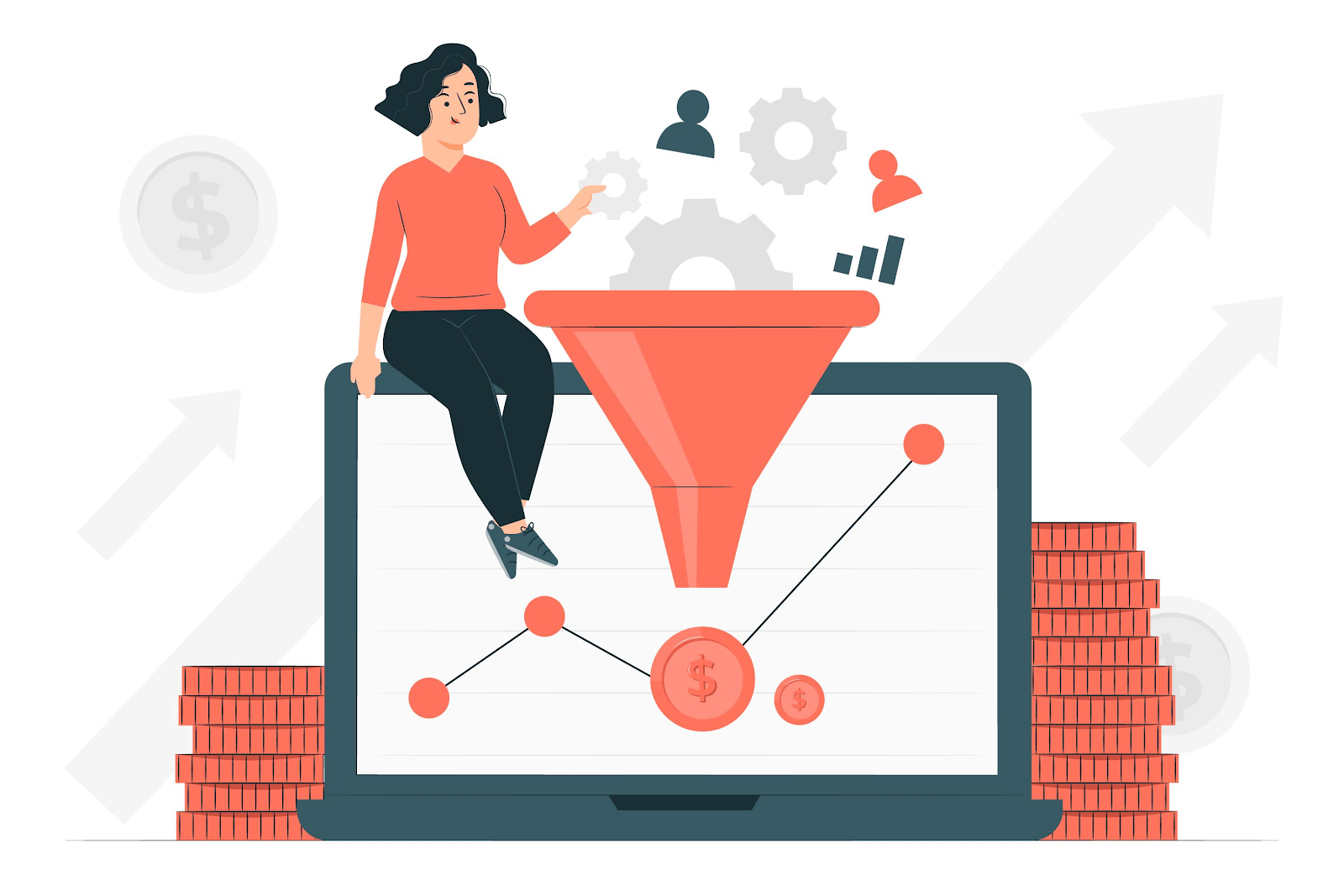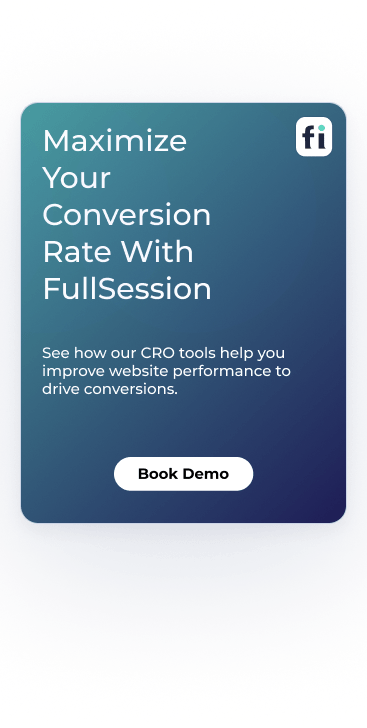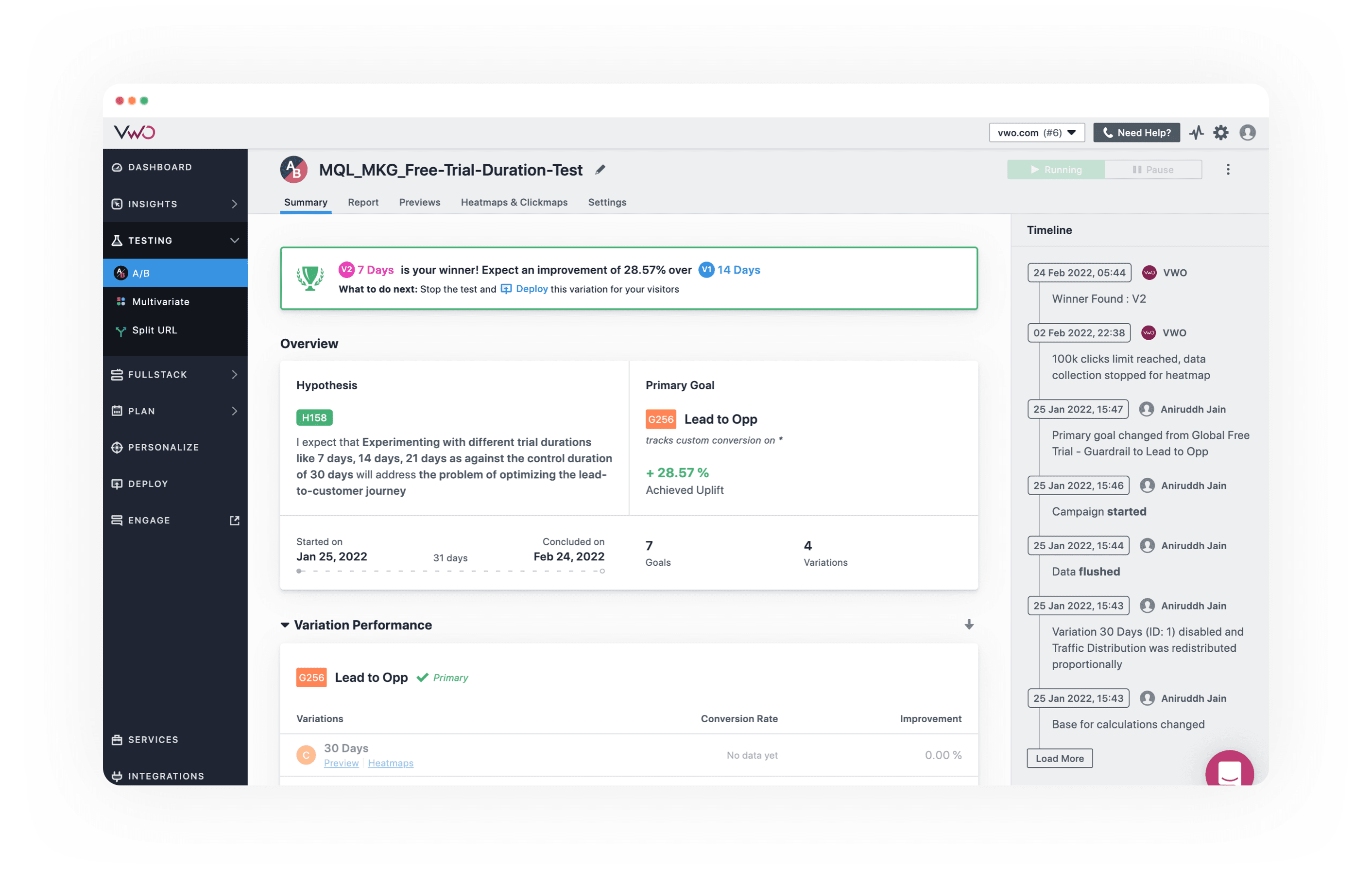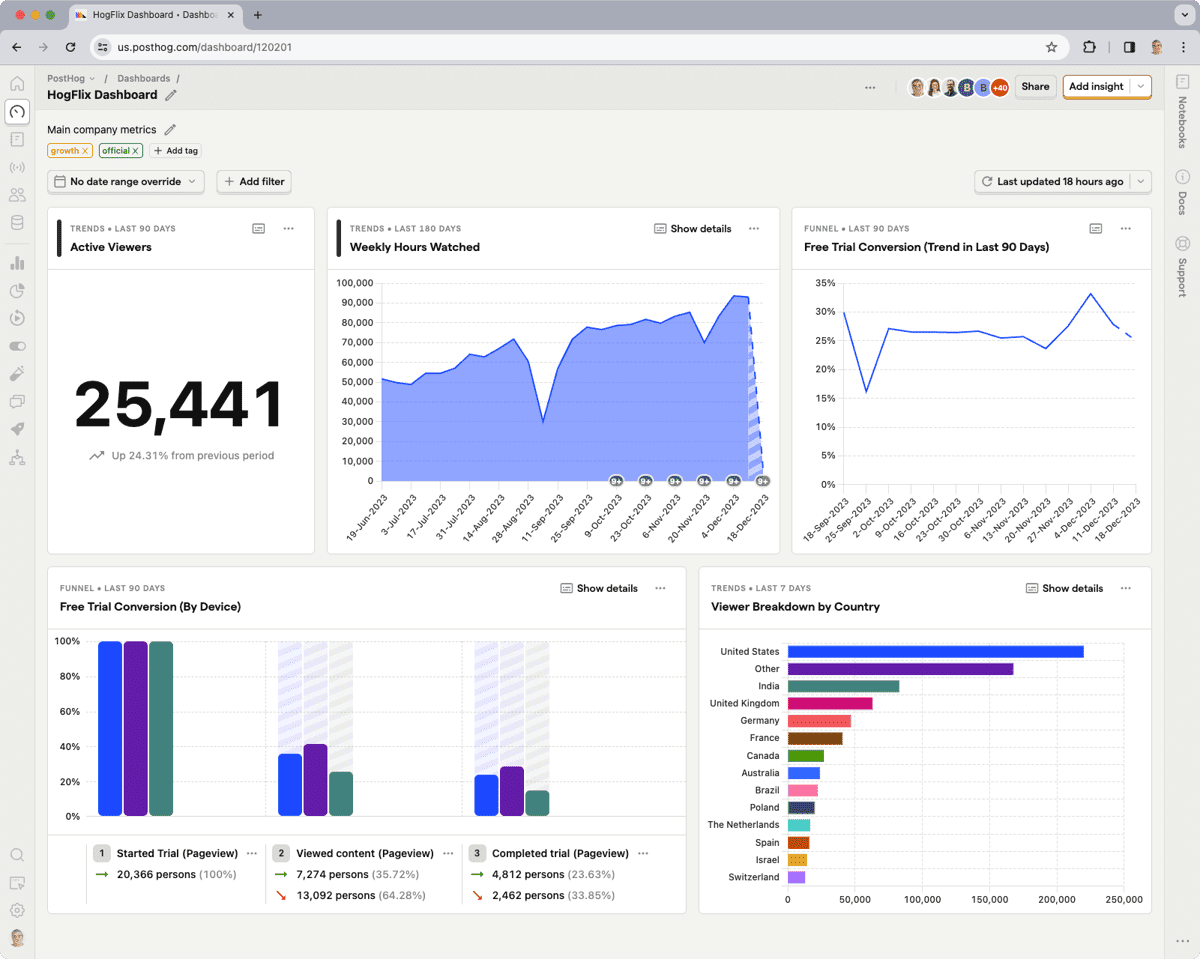Are you looking to optimize your website's performance but unsure if VWO is the right choice? You're in luck! We've compiled...
The ideal customer moves through the conversion funnel with little friction–they view your website, click on your CTAs, and dive head-first into your desired action. Done!
Unfortunately, real-world customers aren't like that. Sure, some may convert into repeat customers without much pushing, but most will need convincing that you are the #1 solution to their problem.
Conversion funnel analysis is all about identifying the strengths and weaknesses of your conversion funnel. It's the backbone of optimization, which is what you need to do to turn every lead into the ideal customer.
You also need the right tools for conversion funnel optimization.
Take FullSession as an example. It provides you with advanced CRO tools that help you conduct a detailed analysis of user journeys, enabling you to track, understand, and optimize each step of your conversion funnel.
You can start a free trial or get a demo to learn more.
In this guide, we'll go over everything you need to know about conversion funnel analysis, the steps involved, key metrics to track, and best practices to follow.
We will also show you how to use FullSession to capture all user interactions, visualize user behavior, analyze trends and patterns with laser precision and optimize your conversion funnel for peak performance.
What is a Conversion Funnel?
Conversion funnels, also known as sales funnels, map the customer journey by breaking it down into key stages, from the first point of contact to completing the desired action, such as making a purchase.
These funnels typically include stages like awareness, interest, consideration, and action, helping you visualize how potential customers move through decision-making.
Unlike a marketing funnel, which covers the broader process of building awareness and nurturing relationships, a conversion funnel zeroes in on the specific steps that lead to a desired action, focusing entirely on driving conversions.
Maximize Your Conversion Rate With FullSession
See how our CRO tools help you improve website performance to drive conversions.
Why Are Conversion Funnels Important?
Conversion funnels guide potential customers through the buying process, from first learning about your product to purchasing. By mapping this journey, you can see where people might drop off and how to improve their experience.
Using conversion funnels makes your marketing efforts more efficient. Instead of guessing what’s working, you can focus on specific steps that lead to conversions. It means you can allocate resources where they need to be and get the most out of your budget.
One of the biggest benefits of an effective conversion funnel is it improves the customer experience. By knowing each stage of their journey, you can address their needs and concerns better. It leads to higher satisfaction and loyalty as customers feel heard and valued.
Including conversion funnels in your strategy supports your ultimate goal: more conversions. By analyzing funnel data, you can find opportunities to get more sales and increase ROI.
Conversion funnels play a big role in how your business connects with potential customers. Focusing on each journey step can build better relationships, improve customer experiences, and help your brand grow.
The Key Conversion Funnel Stages
Image source: BotPenguin
Knowing the conversion funnel stages helps you guide potential customers through their journey so they move from awareness to advocacy. Each stage has its focus and strategy to engage and convert visitors.
Stage 1: Awareness – Grab initial attention
Image source: Cieden
At the awareness stage you need to grab the attention of potential customers. It is where you introduce your brand and your product. You can do this through advertising, social media or content marketing.
Focusing on the problems your product solves is a good approach. Content marketing is particularly effective here. Blog posts, videos and infographics that address common pain points will make customers notice your brand. Remember, it’s not just to inform but to intrigue.
Make sure your branding is consistent and memorable. A good first impression will lead to more engagement in the next stages.
Stage 2: Interest – Engage with your brand
Once you’ve grabbed attention, it’s time to engage your audience more. At this stage, focus on building relationships. Provide content that shows the value of your product or service, like webinars, tutorials or newsletters.
Use email marketing to keep your brand top of mind for potential buyers. Exclusive content or offers will increase interest. Social proof, like testimonials and reviews, plays a big part in providing credibility.
Track the data to see what content or campaigns are performing. It will help you tailor future efforts to maintain and increase engagement and reduce drop-off points.
Stage 3: Consideration – Nurturing customers
At the consideration stage, users evaluate whether your offering meets their needs. Providing detailed comparisons, case studies, and success stories can be valuable here. These resources will help potential customers see real-life applications of your product.
Webinars and demos are great for showing features and benefits. Invite prospects to ask questions and respond promptly. It builds trust and confidence in your brand.
Listen to feedback and be prepared to address objections. It will nurture trust and bring you one step closer to converting leads into buyers.
Stage 4: Intent – Encourage decision
Image source: UserMotion
At the intent stage, prospects are nearly ready to buy. They need a final push to make a decision. Incentives like discounts, free trials or limited-time offers can be effective.
Make the buying process simple. Complications here will lose sales. A smooth checkout process is key to reducing drop-off.
Showcase the unique selling points of your product that differentiate you from the competition. Provide clear calls to action (CTAs) to guide prospects to the final step of conversion.
Stage 5: Purchase – Convert prospects into customers
It is the stage where prospects become customers. Make the purchase experience seamless and enjoyable. Offer multiple payment options and confirm the transaction with clear communication.
Follow up with a thank you email or note to make the customer feel special. It can include reassurance, like support info, in case they run into issues.
Meet deadlines and deliver quality products, and your brand reputation will grow. Happy customers will come back and move further along the journey.
Stage 6: Retention – Keep customers coming back
Retention is about keeping customer satisfaction and encouraging repeat business. Communicate regularly via newsletters or updates about new products and features.
Consider creating loyalty programs to reward repeat customers. A personal experience will deepen the connection with your brand. Use customer feedback to continually improve and meet evolving needs.
Respond to inquiries and complaints so customers always feel heard and valued. This proactive approach will turn a one-time customer into a lifelong fan.
Stage 7: Advocacy – Convert customers into promoters
Advocacy is the final conversion stage, where happy customers become brand advocates. Ask customers to share their experiences by providing easy ways to leave reviews.
Consider a referral program that incentivizes them to recommend your product. Engage with customers on social media to increase visibility and spread the word.
Having a community of customers who actively promote your brand is priceless. Their testimonials and recommendations carry more weight than traditional advertising and will generate new leads at the top of the funnel.
What is Conversion Funnel Analysis?
Image source: mParticle documentation
Conversion funnel analysis shows how visitors move through different stages of your website or app. The journey starts wide with many users in the awareness stage and narrows down to the action stage, where some convert into customers.
It looks at the whole funnel from start to finish and identifies drop-off points where users leave. You can improve weak points and convert prospects by finding these areas.
Funnel analysis is not a one-time task; it requires continuous monitoring and optimization. Product and marketing teams rely on these insights to adjust strategies and ensure effectiveness.
Choosing the best funnel analysis tool, like FullSession, will help you track each stage and increase your revenue. You can create data-driven strategies that deliver measurable results by tracking key events and understanding how users move through the funnel.
It is especially important for ecommerce conversion optimization. FullSession helps you visualize and analyze customer behavior to optimize the ecommerce conversion funnel for better results.
Drive Revenue Growth With FullSession
Learn how to visualize and improve each step in your sales or marketing funnel.
What is your conversion funnel analysis telling you?
Your conversion funnel reveals:
- Where users are dropping off: Pinpointing the exact stage where most visitors exit helps you identify friction points that need attention.
- Which stages perform well: Knowing which parts of your funnel retain users helps you replicate successful strategies elsewhere.
- What your audience wants: Patterns in user actions can show what resonates most, guiding content, product, or campaign adjustments.
For example, a high drop-off rate on a checkout page might suggest usability issues or unclear pricing, while a strong engagement rate in the awareness stage indicates your campaigns are driving quality traffic.
By decoding these signals, you can improve your approach and effectively guide users toward conversion.
Conversion funnel analysis example
Imagine you run an e-commerce site and notice the following through your company's conversion funnel analysis:
- Awareness stage: You attract 10,000 target audience monthly through ads and SEO.
- Consideration stage: Out of these, 5,000 browse product pages.
- Intent stage: From there, 2,000 people add items to their cart.
- Action stage: Only 500 complete the purchase.
This data spotlights a critical drop-off point: 1,500 users abandon their carts. Digging deeper reveals that most users leave due to high shipping costs. With this insight, you could introduce free shipping for orders over a certain amount or simplify the checkout process.
The result? Data-backed marketing strategy drives higher sales conversion rates and more revenue.
Key Conversion Funnel Metrics And KPIs
Image source: Userflow
When looking at your conversion funnel, consider the following metrics and KPIs:
- Conversion Rate: This key number shows how well you convert site visitors into paying customers.
- Click-Through Rate (CTR): This shows how often people click on your ads or emails. A high CTR means your message is resonating with your audience.
- Bounce Rate: If many people are leaving after just one page, your bounce rate will be high. It means your content isn't engaging for potential buyers.
- Average Order Value (AOV): For e-commerce businesses, knowing the average amount customers spend per order is key. Improving this metric will increase revenue per sale.
- Customer Lifetime Value (CLV): It estimates the total revenue a customer will generate during their relationship with your brand. It will help you prioritize efforts to retain and attract the right customers.
- Lead-to-Customer Ratio: This shows how well you convert leads into actual customers. If this ratio is low, review your strategies for nurturing potential customers.
- Cart Abandonment Rate: If many people leave items in their cart without buying, it means there's an issue with the checkout process.
- Cost Per Acquisition (CPA): Know the cost of getting a new customer. It is key to understanding the return on investment of your marketing.
- Pageviews Per Visit and Time on Site: These metrics show users' engagement with your site. More pages viewed and longer visits mean more interest in your product or service.
Monitor these metrics, and you'll see where your funnel works or needs to be improved.
How to Conduct Conversion Funnel Analysis with FullSession
FullSession is a user behavior analytics software that allows you to visualize all user engagement, analyze trends and patterns with laser precision, and optimize your website for peak performance.
With tools like session recordings and replays, interactive heatmaps, feedback widgets, conversion funnel analysis and error tracking, FullSession helps you discover actionable insights and improve the user experience.
FullSession provides a detailed breakdown of user journeys, allowing you to track, understand, and optimize each step of your conversion funnel. Here's how to leverage its key features.
Funnel steps
Start by looking at the funnel steps. It will show you how users move through each stage of the process—from their first touch to conversion. You can track the conversion rate and see where most users drop off. Focus on steps with high drop-off rates to find areas to improve.
Funnel trends
Monitor funnel trends. It will show you how user flows and conversion rates change over time. Knowing these trends will help you make better decisions based on factors such as seasonal variations, campaign performance, or shifts in user preferences.
Event correlations
With top events, you can see what actions are driving conversion rates. Use this data to replicate successful patterns and promote them strategically throughout your site to drive similar results.
With top issues, you can see what actions are causing users to abandon the funnel. Remove these obstacles to improve the user journey, whether it’s a confusing form, broken links, or complex navigation.
Effort analysis
With time engaged, you can see how much time users spend at each funnel stage. Long times may signal confusion or frustration. By reducing unnecessary complexities or delays, you can create a smoother experience.
With the revisit rate, you can track how often users leave a step before returning to try again. High revisit rates mean there are bottlenecks in the process you need to streamline.
Segment analysis
Compare funnel performance across different user segments and break down performance by factors like device type, geographic location, or referral source to uncover significant trends in user behavior.
Identify high-performing segments and tailor their experiences to improve user satisfaction and conversion rates.
Time period
Monitor your funnel across different time periods to identify long-term trends and seasonal variations. Track the impact of marketing campaigns, product launches, or external factors such as market conditions to evaluate performance.
Visualize, Analyze, and Optimize with FullSession
See how to transform user data into actionable insights for peak website performance.
Other FullSession Features for Conversion Funnel Analysis
FullSession has several other features that will give you additional insight into user behavior and help you with conversion funnel analysis. Let's explain each of them.
Session recordings and replays
With session recordings and replays, you can see how users navigate your site. These recordings let you watch real user sessions, so you know where users are clicking, how they're scrolling and where they're getting stuck.
Session recording and replay tools help you find problems or friction points preventing conversions. Knowing how people use your site will lead to design and functionality improvements and make it easier to convert visitors into customers.
Interactive heatmaps
Website heatmap tools show where users are clicking, hovering and scrolling. They use colors to show you which elements on your web pages are getting the most attention and which are being ignored.
Website heatmap tools help you understand how users engage with your site. These visual representations of user interactions use color gradients to indicate high and low engagement areas.
FullSession click, scroll and mouse heatmaps help you see which elements of your pages attract attention and which users ignore.
These UX heatmap tools let you adjust your layout and content to guide users' focus toward key conversion points.
Website feedback forms
Website feedback forms let users tell you directly what they think about your website or app. These customer feedback collection tools provide qualitative data and help you understand user concerns or ideas.
With easy-to-set-up forms, you can collect feedback at key points in the user journey and prioritize areas to improve.
Error tracking
Error tracking will help you find and fix network errors, console errors, error logs, JavaScript errors and uncaught exceptions on your site.
It will capture what went wrong and the context of the issue, like which browser was used or what action led to the error.
Fixing these errors will reduce disruptions in the conversion process and keep users on your site.
Get a 360° View of User Behavior
Learn how to visualize and analyze all user interactions in one intuitive dashboard.
10 Conversion Funnel Optimization Strategies
Image source: Freepik
Let's explore ten proven strategies to streamline your funnel, address potential pain points, and improve your website’s ability to convert traffic into meaningful actions.
Mobile experience for seamless conversions
Focus on responsive design so your site adapts to different screens. Speed is everything—fast-loading pages keep customers engaged.
Test your site’s mobile usability to find areas to improve. Simplify the mobile checkout to remove barriers and increase conversions.
Simplify your site navigation to reduce friction
Clear navigation makes it easier for users to find what they want. Use simple menus and categories to avoid confusion. Limit the number of clicks to get to key pages.
Make your calls to action stand out. By reducing friction, you’ll guide visitors to the action you want them to take.
Use exit-intent popups to keep leaving visitors
Exit-intent popups are the last chance to engage with users about to leave your site. Offer a special discount or a useful guide to grab their attention.
Keep the message short and relevant to keep them around. Testing different offers will help you find what gets the most engagement.
Simplify your checkout to minimize abandonment
A long checkout process can cause cart abandonment. Reduce the number of steps to complete a purchase. Offer guest checkout to avoid long account creation.
Suggest multiple payment options to cater to different preferences. It will help conversion rate optimization by making it easier and faster.
Use behavioral triggers for timing
Understanding user behavior will help you engage with customers at the right time. Set up triggers for actions like browsing a specific product or time on a page.
Send personalized emails or messages to encourage the next step. This timely engagement will build a connection with potential buyers and convert effectively.
Use dynamic content for personalization
Content tailored to individual user behavior will improve the user experience. Use data to show relevant products or offers based on browsing history.
Show content that matches user interests and increases conversions. Dynamic content will make visitors feel understood and valued and give a more personal experience.
Set up retargeting campaigns for lost leads
Not all visitors will convert on the first visit. Retargeting campaigns will remind them of what they left behind. Use ads with products they viewed or related items.
It will keep your brand top of mind and get potential customers to come back and complete the purchase and optimize your conversion funnel.
A/B test key funnel elements
A/B testing helps identify the most effective versions of web pages. It also allows you to optimize key elements of your conversion funnel, such as headlines, images and calls to action.
Running an A/B test involves comparing user actions between the different variants. You can identify which variations drive higher engagement and conversions by testing different versions.
A/B tests can directly measure the impact on key metrics like activation, retention, and revenue.
To run an effective A/B test, create multiple variants of a specific element and use analytics tools to track performance against key metrics like activation, retention, and revenue.
Segmenting users properly for valid results and ensuring the test runs long enough to achieve statistical significance is important.
Analytics tool integration is crucial for tracking A/B test performance.
By regularly testing and refining based on data, you can make informed decisions to improve your conversion funnel and website performance.
Use multi-step forms for better engagement
Breaking forms into multiple steps makes them feel more manageable. Show one question or field at a time to guide the user through the process.
It often results in higher completion rates, encouraging the user to continue. You can get the information you need without scaring the user with long forms up front.
Conclusion About Conversion Funnel Analysis
Conversion funnel analysis is like having a map for your business. It will show you how customers go from being curious to being buyers. It will give you valuable insights to improve your strategies and succeed.
Every step of the funnel, from awareness to purchase, needs attention. Focusing on these steps lets you see where customers drop off and make changes to improve the journey. Modifying these areas will increase conversion rates and customer satisfaction.
Key metrics like conversion rate and click-through rate will guide your decisions. These numbers will tell you what’s working and needs to be tweaked.
Reviewing your conversion funnel regularly will grow your business. It’s an ongoing process that requires patience and observation. With persistence, your efforts will pay off.
For effective funnel analysis and optimization, FullSession is the perfect solution. Its advanced features, like session recordings and replays, dynamic heatmaps, feedback widgets, detailed conversion funnel tracking and error analysis, give you the insights to make data-driven decisions and continuously optimize your website’s performance.
Ready to optimize your conversion funnel? Start using FullSession today and take your website’s performance to the next level!
FAQs About Conversion Funnel Analysis
Let’s answer the most common questions about conversion funnel analysis.
What are the stages of the conversion funnel?
The conversion funnel consists of:
- Awareness: Potential customers find your product or service.
- Interest: They show interest by browsing more.
- Consideration: They consider the benefits and features.
- Intent: They express buying intent.
- Purchase: They complete the purchase.
How do you calculate the conversion funnel?
Use the formula:
Funnel Conversion Rate = (Conversions / Leads) x 100
It will show you how many leads turn into actual customers. Depending on many factors, you may find the conversion rate is between 3% and 7%.
What is the conversion funnel framework?
This framework shows the customer journey in a funnel shape. It’s used to identify where users drop off. The framework helps optimize your marketing strategy to better convert customers.
What are the key characteristics of a conversion funnel?
Some of the key characteristics are:
- Stages: Defined stages that reflect customer behaviour.
- Narrowing path: Fewer users at each stage.
- Optimization opportunities: Helps you pinpoint areas to improve.
- User experience focus: Understanding and improving each step from first touch to purchase.






